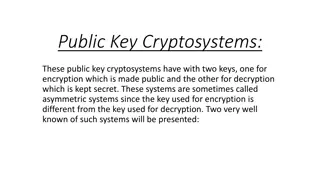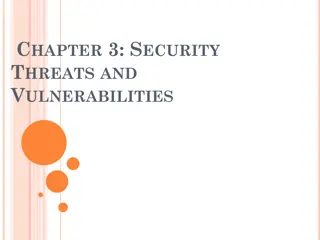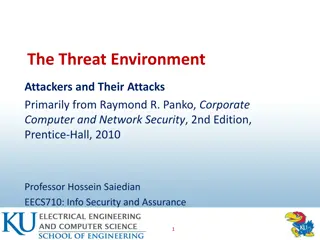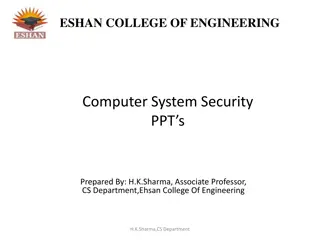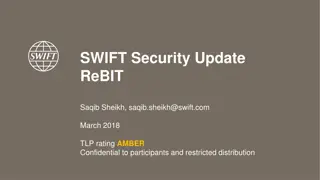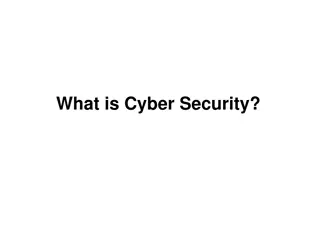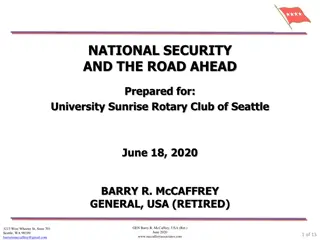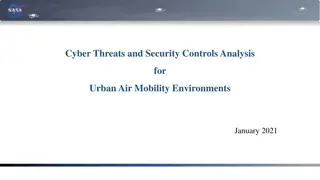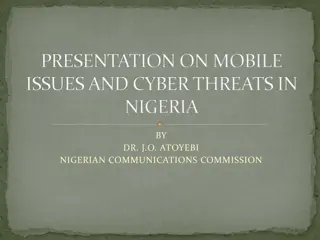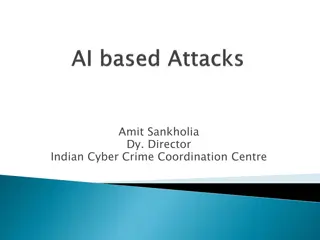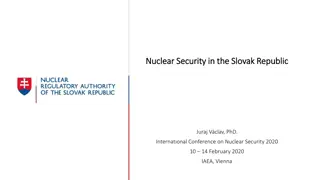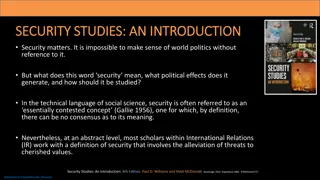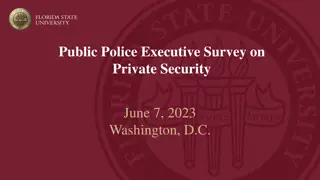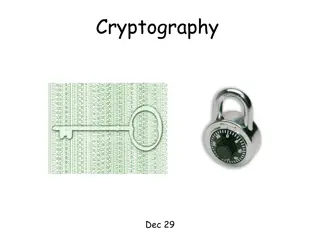Understanding Security Threats and Public-Key Cryptosystems
Explore the world of security threats, passive and active attacks, and the importance of asymmetric encryption through the terminology related to asymmetric encryption, public-key cryptosystems, and public-key cryptography. Learn about the key components of public-key encryption schemes and the process of encryption and decryption using public and private keys.
Download Presentation

Please find below an Image/Link to download the presentation.
The content on the website is provided AS IS for your information and personal use only. It may not be sold, licensed, or shared on other websites without obtaining consent from the author. Download presentation by click this link. If you encounter any issues during the download, it is possible that the publisher has removed the file from their server.
E N D
Presentation Transcript
Security Threats Security Threats / Attacks
Terminology Related to Asymmetric Encryption Asymmetric Keys: Two related keys, a public key and a private key, that are used to perform complementary operations, such as encryption and decryption or signature generation and signature verification. Public Key (Asymmetric) Cryptographic Algorithm: A cryptographic algorithm that uses two related keys, a public key and a private key. The two keys have the property that deriving the private key from the public key is computationally infeasible.
Public-Key Cryptosystems Asymmetric algorithms rely on one key for encryption and a different but related key for decryption. These algorithms have the following important characteristic. It is computationally infeasible to determine the decryption key given only knowledge of the cryptographic algorithm and the encryption key. In addition, some algorithms, such as RSA, also exhibit the following characteristic. Either of the two related keys can be used for encryption, with the other used for decryption.
A public-key encryption scheme has the following ingredients: Plaintext: This is the readable message or data that is fed into the algorithm as input. Encryption algorithm: The encryption algorithm performs various transformations on the plaintext. Public and private keys: This is a pair of keys that have been selected so that if one is used for encryption, the other is used for decryption. The exact transformations performed by the algorithm depend on the public or private key that is provided as input.
Ciphertext: This is the scrambled message produced as output. It depends on the plaintext and the key. For a given message, two different keys will produce two different ciphertexts. Decryption algorithm: This algorithm accepts the ciphertext and the matching key and produces the original plaintext.
The essential steps are the following: 1. Each user generates a pair of keys to be used for the encryption and decryption of messages. 2. Each user places one of the two keys in a public register or other accessible file. This is the public key. The companion key is kept private. As the figure suggests, each user maintains a collection of public keys obtained from others. 3. If Bob wishes to send a confidential message to Alice, Bob encrypts the message using Alice s public key. 4. When Alice receives the message, she decrypts it using her private key. No other recipient can decrypt the message because only Alice knows Alice s private key.
With this approach, all participants have access to public keys, and private keys are generated locally by each participant and therefore need never be distributed. As long as a user s private key remains protected and secret, incoming communication is secure. At any time, a system can change its private key and publish the companion public key to replace its old public key.
We refer to the key used in symmetric encryption as a secret key. The two keys used for asymmetric encryption are referred to as the public key and the private key. The private key is kept secret, but it is referred to as a private key rather than a secret key to avoid confusion with symmetric encryption.
Some of the important aspects of symmetric and public key encryption are
Let us take a closer look at the essential elements of a public-key encryption scheme. There is some source A that produces a message in plaintext, X = [X1, X2, , XM]. The M elements of X are letters in some finite alphabet. The message is intended for destination B. B generates a related pair of keys: a public key, PUb, and a private key, PRb. PRb is known only to B, whereas PUb is publicly available and therefore accessible by A.
With the message X and the encryption key PUb as input, A forms the ciphertext Y = [Y1, Y2, , YN]: Y = E(PUb, X) The intended receiver, in possession of the matching private key, is able to invert the transformation: X = D(PRb,Y) This provides confidentiality
The two related keys can be used for encryption, with the other being used for decryption. This enables a rather different cryptographic scheme to be implemented. In the next Figure the use of public-key encryption to provide authentication is illustrated:
Public-Key Cryptosystem: Authentication and Secrecy X = D(PUa,Y) Y = E(PRa,X) Z = E(PUb, E(PRa,X)) X = D(PUa, D(PRb, Z))
In this case, A prepares a message to B and encrypts it using A s private key before transmitting it. B can decrypt the message using A s public key. Because the message was encrypted using A s private key, onlyAcould have prepared the message. Therefore, the entire encrypted message serves as a digital signature. In addition, it is impossible to alter the message without access to A s private key, so the message is authenticated both in terms of source and in terms of data integrity
Transmitting Y to B is not secured (there is no protection of confidentiality because any observer can decrypt the message by using the sender s public key). It is, however, possible to provide both the authentication function and confidentiality by a double use of the public-key scheme: Z = E(PUb, E(PRa,X)) X = D(PUa, D(PRb, Z))
Applications for Public-Key Cryptosystems We can classify the use of public-key cryptosystems into three categories: Encryption/decryption: The sender encrypts a message with the recipient s public key. Digital signature: The sender signs a message with its private key. Signing is achieved by a cryptographic algorithm applied to the message or to a small block of data that is a function of the message. Key exchange: Two sides cooperate to exchange a session key.
Some algorithms are suitable for all three applications, whereas others can be used only for one or two of these applications.
One-way function A one-way function is one that maps a domain into a range such that every function value has a unique inverse, with the condition that: the calculation of the function is easy, whereas the calculation of the inverse is infeasible: Y = f(X) easy X = f -1 (Y) infeasible
Trap-door one-way function trap-door one-way function, is easy to calculate in one direction and infeasible to calculate in the other direction unless certain additional information is known. With the additional information the inverse can be calculated in polynomial time. A trapdoor one-way function is a family of invertible functions fk, such that: Y = fk(X) easy, if k and X are known X = fk-1 (Y) easy, if k and Y are known X = fk-1 (Y) infeasible, if Y is known but k is not known
The RSA Algorithm by Rivest, Shamir & Adleman of MIT in 1977 best known & widely used public-key scheme uses large integers (eg. 1024 bits) security due to cost of factoring large numbers The RSA scheme is a cipher in which the plaintext and ciphertext are integers between 0 and n - 1 for some n. A typical size for n is 1024 bits, or 309 decimal digits. That is, n is less than 21024.
Description of the Algorithm Plaintext is encrypted in blocks. each block having a binary value less than some number n. That is, the block size must be less than or equal to log2(n) + 1. in practice, the block size is i bits, where 2i < n < 2i+1 . Encryption and decryption are of the following form,:
for some plaintext block M and ciphertext block C. C = Me mod n M = Cd mod n = (Me)d mod n = Med mod n Both sender and receiver must know the value of n. The sender knows the value of e, and only the receiver knows the value of d. Thus, this is a public-key encryption algorithm with a public key of PU = {e, n} and a private key of PR = {d, n}.
For this algorithm to be satisfactory for public-key encryption, the following requirements must be met. 1. It is possible to find values of e, d, and n such that Med mod n = M for all M < n. 2. It is relatively easy to calculate Me mod n and Cd mod n for all values of M <n. 3. It is infeasible to determine d given e and n. We need to find a relationship of the form Med mod n = M
The relationship between e and d can be expressed as ed mod (n) = 1 This is equivalent to saying ed 1 mod (n) d = e-1 mod (n) d and e are relatively prime to (n) The ingredients of RSA are the following: p, q, two prime numbers (private, chosen) n = pq (public, calculated) e, with gcd( (n), e) = 1; 1 < e < (n) (public, chosen) d = e-1(mod (n)) (private, calculated)
The private key consists of {d, n} The public key consists of {e, n}. Suppose that Alice has published its public key and that Bob wishes to send the message M to Alice. Then Bob calculates C = Me mod n and transmits C. On receipt of this ciphertext, Alice decrypts by calculating M = Cd mod n.
How to calculate d Example: p = 17; q = 31, e = 7 Calculate d ? ? 1 ??? ? ???: ? = ? 1 ? 1 = 17 1 31 1 = 480 ? 1??? ? ? Convert congruence to equal = k ? =1 + ???? ? ? =1 + ? ? 0 1 2 3 4 5 0.14 68.71 137.28 205.85 274.42 343 ? Try several numbers for k=0, 1, 2, until you get an integer result
Example: Perform encryption and decryption using the RSA algorithm for plaintext input of M = 88 For this example, the keys were generated as follows. 1. Select two prime numbers, p = 17and q = 11. 2. Calculate n = pq = 17 * 11 = 187. 3. Calculate (n) = (p - 1)(q - 1) = 16 * 10 = 160. 4. Select e such that e is relatively prime to (n) = 160 and less than (n); we choose e = 7. Determine d such that de 1 (mod 160) and d < 160. 5. The correct value is d = 23, because 23 * 7 = 161 = (1 * 160) + 1; d can be calculated using the extended Euclid s algorithm
The resulting keys are: Public key PU= {7, 187} and Private key PR = {23, 187}. In this example the plaintext input of M = 88. For encryption, we need to calculate C = 887 mod 187. Exploiting the properties of modular arithmetic as follows: 887mod 187 = [(884mod 187) * (882mod 187) * (881mod 187)] mod 187 881mod 187 = 88 882mod 187 = 7744 mod 187 = 77 884mod 187 = 59,969,536 mod 187 = 132 887mod 187 = (88 * 77 * 132) mod 187 = 894,432 mod 187 = 11
For decryption, we calculate M = 1123mod 187: 1123mod 187 = [(111mod 187) * (112mod 187) * (114mod 187) * (118mod 187) * (118mod 187)] mod 187 111mod 187 = 11 112mod 187 = 121 114mod 187 = 14,641 mod 187 = 55 118mod 187 = 214,358,881 mod 187 = 33 1123mod 187 = (11 * 121 * 55 * 33 * 33) mod 187 = 79,720,245 mod 187 = 88
Example: the use of RSA to process multiple blocks of data. In this simple example, the plaintext is an alphanumeric string. Each plaintext symbol is assigned a unique code of two decimal digits (e.g., a = 00, A = 26). A plaintext block consists of four decimal digits, or two alphanumeric characters. The sequence of events for the encryption of multiple blocks is as shown (the circled numbers indicate the order in which operations are performed).
The Security of RSA 1. Brute force: This involves trying all possible private keys. 2. Mathematical attacks: There are several approaches, all equivalent in effort to factoring the product of two primes. 3. Timing attacks: These depend on the running time of the decryption algorithm. 4. Hardware fault-based attack: This involves inducing hardware faults in the processor that is generating digital signatures. 5. Chosen ciphertext attacks: This type of attack exploits properties of the RSA algorithm.
The Factoring Problem We can identify three approaches to attacking RSA mathematically. Factor n into its two prime factors. This enables calculation 1. of (n) = (p - 1) * (q - 1), which in turn enables determination of d e-1 (mod (n)). Determine (n) directly, without first determining p and q. 2. Again, this enables determination of d e-1 (mod (n)). Determine d directly, without first determining (n). 3.
Timing Attacks Paul Kocher, a cryptographic consultant in mid-1990 s, demonstrated that: A snooper can determine a private key by keeping track of how long a computer takes to decipher messages. Timing attacks are applicable not just to RSA, but to other public-key cryptography systems. This attack is alarming for two reasons: It comes from a completely unexpected direction It is a ciphertext-only attack.
Although the timing attack is a serious threat, there are simple countermeasures that can be used, including the following. Constant exponentiation time: Ensure that all exponentiations take the same amount of time before returning a result. This is a simple fix but does degrade performance. Random delay: Better performance could be achieved by adding a random delay to the exponentiation algorithm to confuse the timing attack. Blinding: Multiply the ciphertext by a random number before performing exponentiation. This process prevents the attacker from knowing what ciphertext bits are being processed inside the computer and therefore prevents the bit-by-bit analysis essential to the timing attack.
Fault-Based Attack The approach is an attack on a processor that is generating RSA digital signatures. The attack induces faults in the signature computation by reducing the power to the processor. The faults cause the software to produce invalid signatures, which can then be analyzed by the attacker to recover the private key. The authors show how such an analysis can be done and then demonstrate it by extracting a 1024-bit private RSA key in approximately 100 hours, using a commercially available microprocessor.
Chosen Ciphertext Attacks RSA is vulnerable to a Chosen Ciphertext Attack (CCA) . Attackers chooses ciphertexts & gets decrypted plaintext back. Choose ciphertext to exploit properties of RSA to provide info to help cryptanalysis can counter with random pad of plaintext or use Optimal Asymmetric Encryption Padding (OASP)


